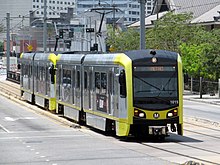
Back قطار خفيف Arabic Yüngül relsli sistem AZ লঘু রেল Bengali/Bangla Tren lleuger Catalan Letbane Danish Light rail vehicle German Malpeza trajno EO Tren ligero Spanish Tren ligeru EXT قطار سبک شهری FA

Light rail (or light rail transit, abbreviated to LRT) is a form of passenger urban rail transit that uses rolling stock derived from tram technology[1] while also having some features from heavy rapid transit.
The term was coined in 1972 in the United States as an English equivalent for the German word Stadtbahn, meaning "city railway".[2][3] Different definitions exist in some countries, but in the United States, light rail operates primarily along exclusive rights-of-way and uses either individual tramcars or multiple units coupled together, with a lower capacity and speed than a long heavy rail passenger train or rapid transit system.[4][5][6][7][8]
Narrowly defined, light rail transit uses rolling stock that is similar to that of a traditional tram, while operating at a higher capacity and speed, often on an exclusive right-of-way. In broader use, it includes tram-like operations mostly on streets.[9] A few light rail networks have characteristics closer to rapid transit or even commuter rail, yet only when these systems are fully grade-separated are they referred to as light metros.
| Part of a series on |
| Rail transport |
|---|
 |
|
|
| Infrastructure |
|
|
| Service and rolling stock |
|
| Urban rail transit |
|
|
| Miscellanea |
|
|
- ^ Vuchic, V.R. (1975). "Place of light rail transit in the family of transit modes". TRB Special Report (161). Transportation Research Board. Retrieved 1 July 2024. National Conference of the Transportation Research Board
- ^ Thompson, Gregory L. (2003). "Defining an Alternative Future: The Birth of the Light Rail Movement in North America". Transportation Research Circular (E-C058). Transportation Research Board. Retrieved 26 December 2009. From: 9th National Light Rail Transit Conference
- ^ "New railway bridge over the Neckar river". Retrieved 24 June 2024.
- ^ "Fact Book Glossary – Mode of Service Definitions". American Public Transportation Association. 2015. Archived from the original on 25 February 2018. Retrieved 6 January 2015.
- ^ "National Transit Database Glossary". U.S. Department of Transportation Federal Transit Administration. 18 October 2013. Archived from the original on 13 November 2013. Retrieved 6 January 2015.
- ^ "What is light rail?". Public transport A-Z. International Association of Public Transport. 2008. Archived from the original on 13 October 2008. Retrieved 29 July 2015.
- ^ "This Is Light Rail Transit" (PDF). Transportation Research Board. pp. 7–9. Archived from the original (PDF) on 17 April 2018. Retrieved 6 January 2015.
- ^ "What is Light Rail?". Light Rail Transit Association (LRTA). Archived from the original on 5 June 2016. Retrieved 6 January 2015.
- ^ Glossary of Transit Terms. 1992. p. 9. Retrieved 24 June 2024.